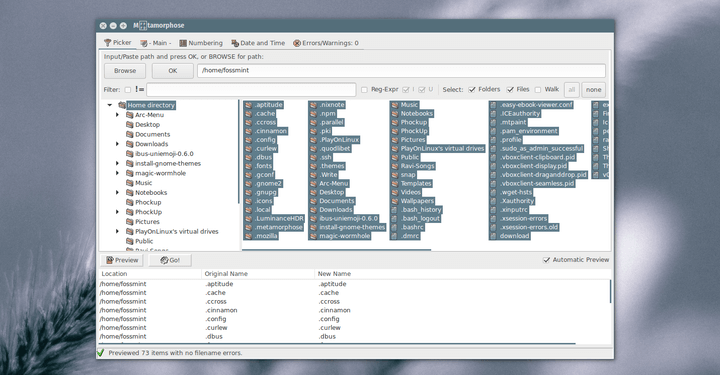

- Linux mass rename items how to#
- Linux mass rename items install#
when you are ready to test that, remove or comment out the -WhatIf parameter at the end of the rename line. The current version of this script DOES NOT rename anything.
builds a new file name by joining the new BaseName and the old. creates a new BaseName for the file by capturing the two parts and switching them. gets the list of files that start with (*). Rename-Item -Path $FL_Item.FullName -NewName $NewName -WhatIfĪfter you test this as-is, just remove the entire #region/#endregion block & set the $TopDir to your target folder. # remove the "-WhatIf" to make actual changes $NewName = -join ($NewBaseName, $FL_Item.Extension) $FileList = Get-ChildItem -LiteralPath $TopDir -Filter '(*)*.*' #endregion > make some files to work with $Null = New-Item -Path $TopDir -Name $_ -ItemType 'File' -Force # the "$Null =" is to supress unwanted output from the cmdlet # when ready to use the real items, remove the entire "#region/#endregion". pdf, use: rename -v 's/.txt/.pdf/' *.Here is one way to do the job. Returning to our last example, to change the file extension from. -v: Shows a verbose version of the output. -s: Renames the target instead of the symlink. Best combined with the verbose output ( -v). -n: Performs a dry run, making no permanent changes. -l: Replaces the last occurrence of the filename element instead of the first one. -i: Displays a prompt before overwriting existing files. -f: Forces an overwrite of existing files. -a: Replaces all the occurrences of the filename element instead of just the first one. The rename command uses the following options: In this example, every a character in the filename is replaced by an x, every b by a y, and every c by a z. This type of expression uses the following syntax: rename 'y///' Īn example of a rename command using a translate expression: rename 'y/abc/xyz/' 
: Defines the file you want to rename.Ī translate expression translates one string of characters into another, character for character.: Specifies a replacement for the part of the current filename.: Specifies the part of the filename you want to replace.: Provides an optional argument that changes the way the command executes.With this syntax, the command renames the file by replacing the first occurrence of the filename element with the replacement. They use the following syntax: rename 's///' Substitute expressions replace a part of the filename with a different string.

The rename command uses substitute and translate expressions to change file and directory names. There are three types of Perl regular expressions: match, substitute and translate.
For Arch Linux, use sudo pacman -S rename. Linux mass rename items install#
For CentOS and Fedora, use sudo yum install prename. For Ubuntu and Debian, use sudo apt install rename. If your system is missing the rename command, install it with: On many Linux distributions, the rename command is not available by default. It offers more features than the mv command but can be more challenging to use since it requires basic knowledge of Perl expressions. The rename command is used to rename multiple files or directories in Linux. Linux mass rename items how to#
Note: Learn how to compare two files using the diff command.







 0 kommentar(er)
0 kommentar(er)
